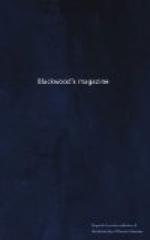Now, here, as on every topic where a comparison is attempted, what must strike every one is, the manifest partiality Mr Carlyle shows to the past, and the unfair preference he gives it over the present. Nothing but respect and indulgence when he revisits the monastery of St Edmunds; nothing but censure and suspicion when he enters, say, for instance, the precincts of Exeter Hall. Well do we know, that if Mr Carlyle could meet such a monk alive, as he here treats with so much deference, encounter him face to face, talk to him, and hear him talk; he and the monk would be intolerable to each other. Fortunately for him, the monks are dead and buried whom he lauds so much when contrasted with our modern pietists. Could these tenants of the stately monastery preach to him about their purgatory and their prayers—lecture him, as assuredly they would, with that same earnest, uncomfortable, too anxious exhortation, which all saints must address to sinners—he would close his ears hermetically—he would fly for it—he would escape with as desperate haste as from the saddest whine that ever issued from some lath-and-plaster conventicle.
Mr Carlyle censures our poor century for its lack of faith; yet the kind of faith it possesses, which has grown up in it, which is here at this present, he has no respect for, treats with no manner of tenderness. What other would he have? He deals out to it no measure of philosophical justice. He accepts the faith of every age but his own. He will accept, as the best thing possible, the trustful and hopeful spirit of dark and superstitious periods; but if the more enlightened piety of his own age be at variance even with the most subtle and difficult tenets of his own philosophy, he will make no compromise with it, he casts it away for contemptuous infidelity to trample on as it pleases. When visiting the past, how indulgent, kind, and considerate he is! When Abbot Samson (as the greatest event of his life) resolves to see and to touch the remains of St Edmund, and “taking the head between his hands, speaks groaning,” and prays to the “Glorious Martyr that it may not be turned to his perdition that he, miserable and sinful, has dared to touch his sacred person,” and thereupon proceeds to touch the eyes and the nose, and the breast and the toes, which last he religiously counts; our complacent author sees here, “a noble awe surrounding the memory of the dead saint, symbol, and promoter of many other right noble things.” And when he has occasion to call to mind the preaching of Peter the Hermit, who threw the fanaticism of the west on the fanaticism of the east, and in order that there should be no disparity between them in the sanguinary conflict, assimilated the faith of Christ to that of Mahommed, and taught that the baptized believer who fell by the Saracen would die in the arms of angels, and at the very gates of heaven; here, too, he bestows a hearty respect on the enthusiastic missionary, and all his




